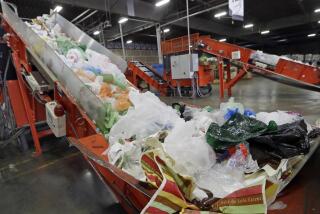Recycled Plastic May Be Headed for the Dump
- Share via
Chula Vista and Imperial Beach may have to cut back on the most ambitious plastics recycling campaigns in the county, begun earlier this year, and dump tons of collected plastic containers into landfills.
In February, the two South Bay cities committed themselves to a recycling program that collected plastic containers of all kinds from single-family households. Other communities with plastic recycling programs collect only plastics such as 2-liter soda bottles, plastic milk containers and water jugs.
But now, Chula Vista and Imperial Beach are finding that while manufacturers are snapping up their recycled 2-liter soda bottles and water and milk jugs, the other plastics, such as margarine and yogurt containers, are piling up.
Several tons of the unwanted plastics are being stockpiled at San Diego Recycling,
the middle man between the company that picks up the containers at the curb and the one that grinds the plastics down for manufacturing use.
“I’m just stuck in the middle,” said Athena Bradley, conservation coordinator at Chula Vista, where 23,000 households participate in the recycling program.
Unless the cities can find a buyer for the mixed plastics sometime this week, they will be dumped into the Otay Landfill and the program will be cut back, Bradley said.
“They had a lot of faith in the ability of the plastics industry to handle those (recycled) plastics, and it appears that their faith was misplaced,” said Kip Sturdevan, recycling director for the Mashburn Sanitation Company in Escondido.
“They were willing to go out on a limb and be aggressive, and it’s unfortunate. They have done their job, and done it very well, and the other end of the line hasn’t come through for them,” Sturdevan said.
The problem, said most of those involved in plastics recycling, is that technology and the marketplace have yet to catch up with communities’ desire to recycle.
There are seven categories of plastics, and even in those categories there are different blends. Each category is distinct and their makeup of various chemical prevent them from being mixed.
Two categories of plastics, the soda bottles and water and milk jugs, compose more than half of the plastics waste stream. That large quantity makes it economically feasible to separate them and recycle them, recyclers said.
The other categories of plastics each compose a very small part of the whole, making them costly to recycle.
“It isn’t so much that there isn’t some demand, but you can’t collect it, sort it, grind it and process it and then sell it and make any money,” said Tom Long, head of Plastic Reprocessing in Vista and San Marcos, which processes mixed plastics.
The sorting of the plastics is done by hand. While aluminum cans can be sorted from steel with the wave of a magnet, there is no such magnet for the dozens of types of plastics, making the task of manually sorting the plastics brutal.
“At this point, the economics of separation are pretty tough,” said Dick Gamble, a consultant to the Council for Solid Waste Solutions, which represents plastic manufacturers that are the primary consumers of the recycled plastics as well as the main manufacturers of new plastics.
“The solution to that, and it is imminent, is an automated system where materials can be separated automatically,” Gamble said. A prototype of that system is being tested in Chicago, he said.
And even if they could be sorted at a reasonable cost, it is uncertain whether there are buyers ready to use them, Gamble said.
“I don’t know where on the West Coast that you can sell them on a consistent basis,” Gamble said.
Long agreed with Gamble.
“What’s happened is that people have been made aware that a lot of plastics can be recycled, and the consumers have been made aware and that’s very good. But the people who are buying this (type of recycled plastic) have mountains of it,” Long said.
On top of that is the fluctuating price of new, “virgin” plastic resin, which rises and falls with the price of oil. At the time that Chula Vista and Imperial Beach began their programs, the war with Iraq was just beginning and oil prices were high, making recycled plastics competitive with virgin plastic resin, Bradley said.
But since the end of the war, oil prices have plummeted, and so has the marketability of some recycled plastics, Bradley said.
Bradley said her city’s decision was based on a county task force’s recommendation that said there would likely be a market for the recycled plastic.
“I think the plastics industry was maybe a little more hopeful than they should have been and we were a little more hopeful than we should have been,” Bradley said.
Richard Anthony, a member of that task force, conceded that “a mistake” had been made.
“We thought that we would have this thing together,” Anthony said.
Now, Chula Vista and Imperial Beach may have to dump the plastics they were hoping to save.
“We’re kind of on pins and needles,” said Lora Steele, management analyst for Imperial Beach, who feels that to cut back on plastics recycling would undermine confidence in the program.
“People are putting them out there on good faith that they are going to be recycled, and to landfill it just isn’t right,” Steele said.
Trisha Ferrand, a solid-waste program coordinator with San Diego County, stressed that the limited failure of the Chula Vista and Imperial Beach programs does not mean failure for the whole program or for others like it.
“The problem is only with certain kinds of plastics. We’re still taking soda bottles and milk jugs,” Ferrand said.
Those bottles and jugs make up as much as 60% of the plastics waste stream, Gamble said.
More to Read
Sign up for Essential California
The most important California stories and recommendations in your inbox every morning.
You may occasionally receive promotional content from the Los Angeles Times.













